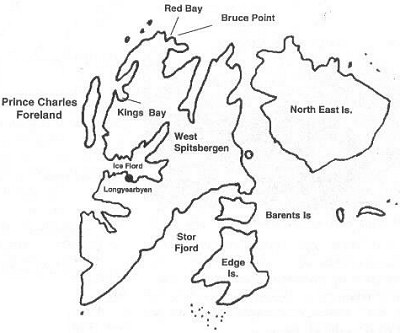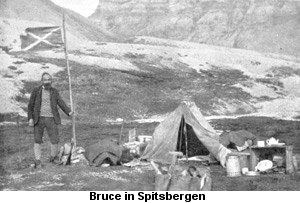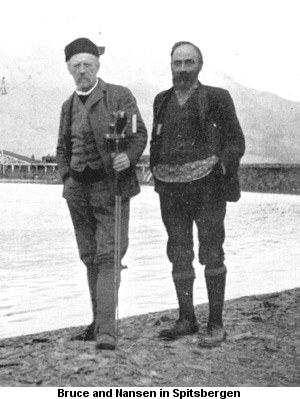
| Glasgow Digital Library | Voyage of the Scotia | BRUCE | PEOPLE | SHIP | ANTARCTIC | INDEX |
|---|
Bruce was involved in a number of different projects when he came home from the Scotia voyage, but if he could not return to the Antarctic then the Arctic was second best. When asked by the Prince of Monaco to return to do survey work in the islands of Spitsbergen he leapt at the chance. The area he was to survey was Prince Charles Foreland - the most westerly of the islands of Spitsbergen (today called Svalbard).

Bruce sailed to Spitsbergen in 1906 with the Prince of Monaco in his research vessel Princess Alice. This was Bruce's third visit to Spitsbergen. He then transferred in the tender Kvedfiord to the scene of his work on Prince Charles Foreland. Bruce was accompanied by G Kerr (the piper on Scotia) and four others.
They landed at Point Carmichael on the north end of the foreland. Bruce mapped the coastline, collected rocks, plants and birds. Once again he made detailed recordings of the wildlife of this remote region.
The island was very rugged and transport was very difficult. Bruce's main task was a detailed survey of the island. Low cloud and mist made surveying of the higher peaks very difficult. Despite the fierce winds, mist, rain and cold temperatures, Bruce was to return several times to Prince Charles Foreland.
In 1907 the Prince of Monaco financed a return trip to Prince Charles Foreland. On this occasion Bruce took with him Burn-Murdoch, Kerr, S Ross and a Norwegian sailor.
On this occasion they travelled on a steamer called Fonix from Tromso. The base camp was to be across from the Edinburgh Islands. Fonix ran aground for a time due to the strong winds blowing down Scotia Glen.

During the summer Bruce was joined by H Jalmar Johansen who had been Nansen's companion on Fram. He was disappointed that Bruce was not overwintering on the island.
Survey work continued, made easier by a sledge designed by Bruce with wheels for dragging across the rough terrain with their survey instruments and supplies.
The tender Kvedfiord was due to collect Bruce but there had been a mix-up in dates so Bruce and his companion had to make a four-day trek across the foreland with all their equipment to where another boat was due to call.
It was two years before Bruce could return to the Arctic. The Prince of Monaco once more helped by supplying the Granton trawler Conqueror. The small survey party included J Mathieson of the Ordnance Survey (aged 54) and Alasdair Geddes - son of Bruce's friend Professor Geddes.
Over the next few years Bruce tried to raise enough money to complete the survey of Prince Charles Foreland.
Wildlife of Prince Charles Foreland
Guillemots, gulls, dovekies, little auks, razorbill, puffins, skuas, eider ducks, snow buntings, purple sandpipers, sanderlings, great northern diver, phalarope. Bruce recorded over 100 foxes which were later to be exterminated by Norwegian trappers. Two reindeer were sighted but no polar bears. Bruce recorded over 60 species of plants.
Coal had been discovered in Spitsbergen in the mid-19th century and Bruce had taken samples back to be tested in Edinburgh in 1898. The main mining activity began in 1904 when the log house of Advent City was erected by a Sheffield Company. The Arctic Coal Company of Boston in the USA bought up many of the 'mining estates' on Spitsbergen and built Longyear City in Advent Bay. In 1908 coal was being exported.
Bruce claimed mining rights in Prince Charles Foreland and in Ice Fiord. In 1908 he handed over these rights to the Scottish Spitsbergen Syndicate of Edinburgh.
The 1909 Spitsbergen expedition not only included a scientific survey but also collected a lot of economic information.

In 1912 Bruce was back in Spitsbergen surveying with Rudmose Brown (from Scotia and also to write Bruce's biography) for a mining syndicate.
The vessel due to pick up Bruce could not enter Ice Fjord, so Bruce and his party decided to make their way to the American mining base on Advent Bay where they would get a coal-carrying ship home.
The party crossed Ice Fjord in a small boat with a rising westerly wind. They had to row and bale amongst the ice floes. They then marched 110km (70 miles) overland with little food and no sleeping bags. The march was non-stop from midday Saturday to Monday morning.
At Advent Bay, Bruce was as fresh as when he started. Before they left Advent Bay the party was entertained aboard Veslemoy, the yacht of the Arctic explorer Nansen.
Bruce had been trying to raise enough money to complete the survey of Prince Charles Foreland. A complete map of Prince Charles Foreland was published at a scale of 1:140,000 by the Prince of Monaco in 1913.
In 1914 Bruce was back in Spitsbergen in a small expedition financed by the Royal Geographical Society and the British Association. This expedition was to do a hydrological survey of Stor Fiord and a geological survey of Prince Charles Foreland. His companions on this occasion included William Burn-Murdoch. They sailed on what proved to be a neutral vessel as the first world war broke out while they were in Spitsbergen. The ship had cargo to deliver to several bases. As the vessel was neutral they had to go to a German base to unload part of their cargo which was coal. The ship ran aground and to lighten the load much of the coal had to be dumped into the sea so she could refloat.
Sovereignty of Spitsbergen
Britain, Norway, Sweden, Russia and the USA all claimed mining rights on Spitsbergen. (Bruce thought it should be British due to Britain's interest and involvement in mining at the time.) During the first world war the countries involved in the war did not have the manpower to continue mining, but Norway and Sweden continued operations and by 1918 were exporting 60,000 tons a year. In 1919 the sovereignty of Spitsbergen was given to Norway.
In 1919 Bruce was back in Spitsbergen. He was asked by a Scottish company to take a large prospecting and surveying party north. The expedition was very successful and they discovered a large new coalfield of good quality coking coal and an enormous deposit of magnetic iron ore. Rudmose Brown was with him again on this expedition. This was the last expedition led by Bruce.
Bruce's health, which had been so good over the years, was beginning to fail (despite an operation). In 1920 he travelled north for the last time on board the Scottish syndicate ship as a passenger.
'The Mercator map gives a distorted impression of the size of Spitsbergen and its distance from Europe.'
'Coal on Spitsbergen is easy to access. The coal can be sent down to the ships anchored in deep water by aerial ropeway. The frozen soil mean pit props are not necessary. There is no flooding of mines and no gas. The export season is four months.'
| Glasgow Digital Library | Voyage of the Scotia | BRUCE | PEOPLE | SHIP | ANTARCTIC | INDEX |
|---|